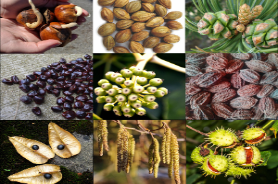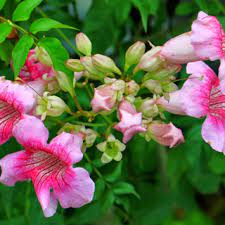Tecoma is a genus of flowering plants that belongs to the family Bignoniaceae. It comprises several species of shrubs or small trees native to the Americas, including North, Central, and South America. Known for their vibrant and showy trumpet-shaped flowers, Tecoma plants are widely admired for their ornamental value.
Appearance and Foliage:
Tecoma plants typically have dense foliage with pinnate or compound leaves. The leaflets are often elongated, lance-shaped, or ovate, and their size and arrangement can vary among species. The leaves are usually bright green, providing an attractive backdrop for the striking flowers.
Flowers and Blooms:
The highlight of Tecoma plants is their stunning trumpet-shaped flowers. The flowers can be large, ranging in color from yellow, orange, or red, depending on the species. They often feature contrasting throat colors and exhibit a tubular shape that flares open into multiple lobes. The blooms are abundant and create a breathtaking display that attracts pollinators such as bees, butterflies, and hummingbirds.
Size and Growth Habit:
Tecoma species can vary in size and growth habit. Some species, such as Tecoma stans (Yellow bells), Tecoma capensis (Cape honeysuckle), and Tecoma grandiflora (Orange trumpetbush), can grow as small trees or large shrubs, reaching heights of several meters. Others, like Tecoma ricasoliana (Desert honeysuckle), are more compact and suitable for smaller gardens or containers.
Light and Temperature Requirements:
Most Tecoma species thrive in full sun or partial shade. They require ample sunlight to produce abundant blooms and maintain healthy foliage. These plants are well-adapted to warm climates and can tolerate high temperatures. However, they may need protection from intense afternoon sun or extremely hot conditions.
Watering and Soil:
Tecoma plants generally prefer well-draining soil. They have moderate water requirements and should be watered deeply but infrequently. It’s important to allow the soil to dry out between watering to prevent overwatering, which can lead to root rot. Applying a layer of organic mulch around the base of the plant can help conserve moisture and suppress weed growth.
Fertilizing and Pruning:
Regular fertilization during the growing season with a balanced, slow-release fertilizer can promote vigorous growth and abundant blooms. Pruning can be done to shape the plant, remove dead or damaged branches, and encourage bushier growth. It is best to prune Tecoma plants after the blooming period to avoid removing potential flower buds.
Pests and Care Tips:
Tecoma plants are generally hardy and not prone to serious pest or disease issues. However, they can be susceptible to aphids, scale insects, or spider mites. Regular inspection and appropriate pest control measures, such as using insecticidal soaps or horticultural oils, can help keep these pests at bay. Providing adequate air circulation and avoiding overcrowding can also minimize the risk of pest infestations.
Conclusion:
Tecoma plants are known for their vibrant and showy trumpet-shaped flowers, making them popular choices for adding color and visual appeal to gardens or landscapes. With their attractive foliage, ability to attract pollinators, and adaptability to warm climates, Tecoma species bring joy and beauty to outdoor spaces. By providing proper care, including suitable light conditions, well-draining soil, and occasional pruning, gardeners can enjoy the striking blooms and lush foliage of Tecoma plants for years to come.















Reviews
There are no reviews yet.